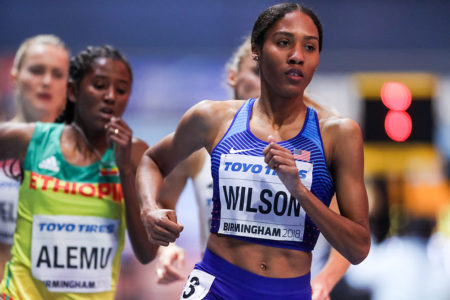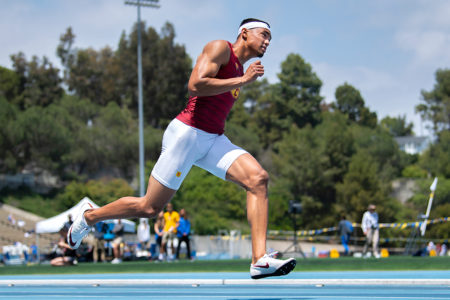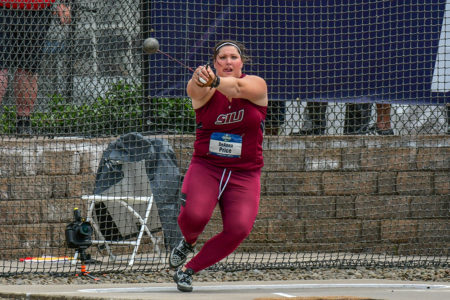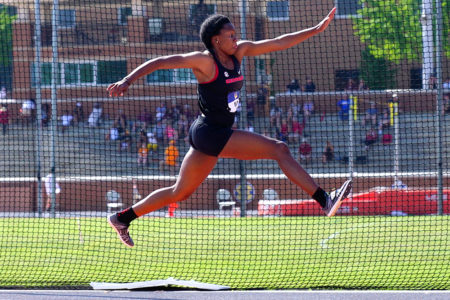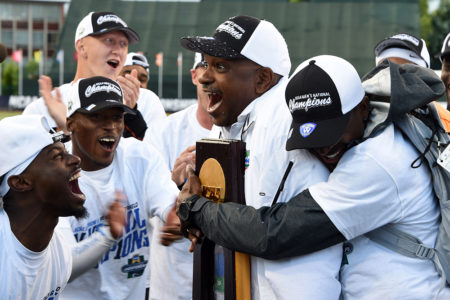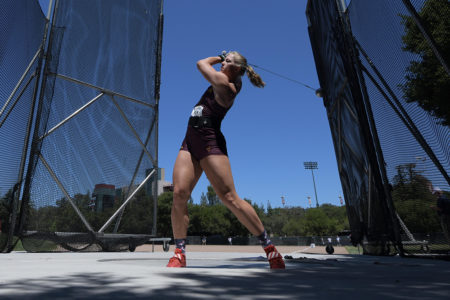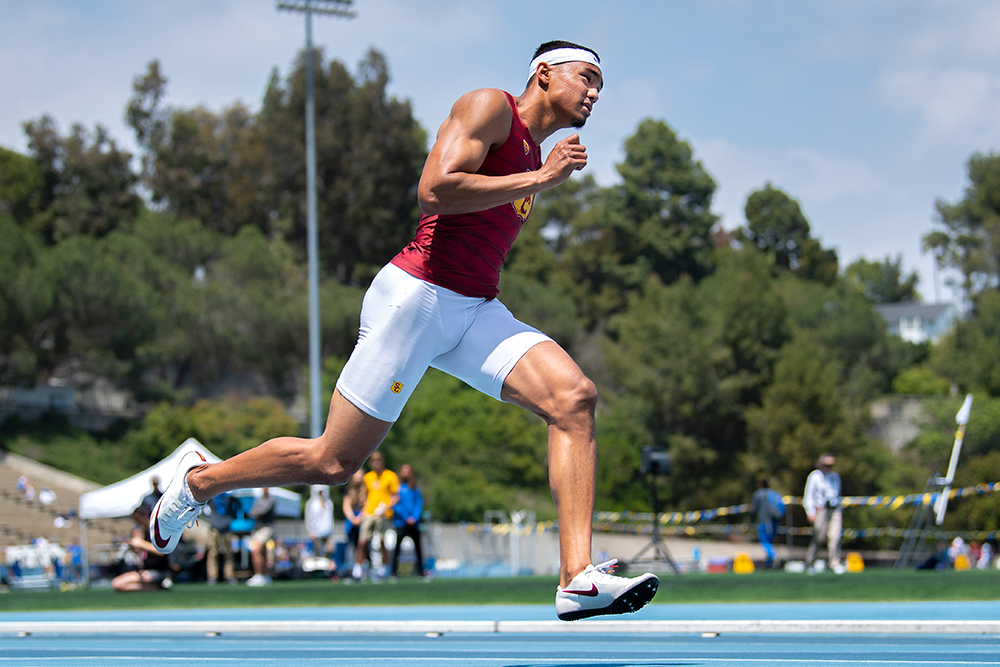
A few months back T&FN correspondent Lee Nichols was the first to suggest it. USC circa 2018 is Quartermiler U.
Nichols posited the accolade—reserved in decades past for the Baylor men—at the NCAA Indoor in March but Trojan Pac-12 and West Regional performances suggest more may be in store this outdoor season at the NCAA Champs.
At the collegiate indoor finale, Michael Norman ran an under-a-roof 400 World Record (44.52), Kendall Ellis the American and Collegiate Records (50.34) and, to wrap up the meet, the Trojan men’s 4×4 unit set the relay CR—with a 3:00.77 clocking faster than the World Record but not conforming to the IAAF requirement that all four stick carriers have the same nation-eligibility.
The women’s 4×4 anchored by Ellis won in 3:27.45, indoor collegiate baton history’s No. 5 time. At the meet’s ’17 edition the Trojan squad set what is still the undercover CR, 3:27.03, and let’s not forget that the ’17 outdoor squad’s 3:23.35 to place 2nd behind Oregon’s CR is No. 2 on the collegiate all-time list.
As we look toward the NCAA, consider also Rai Benjamin in the 1-lap hurdles. At the Pac-12 he stumbled and nearly fell over the third barrier but still ran home, with a stiff breeze challenging his pattern, in 48.46. Benjamin—runner-up by 0.01 at last year’s Nationals for UCLA—said after the Conference meet he believed he could challenge Kerron Clement’s collegiate standard, 47.56, from ’05.
He seemed right then, and only burnished his credentials when he blazed a 47.98 at the Regional, moving to No. 4 on the all-time collegiate list with the fastest NCAA time since the ’05 Nationals.
The Trojans spent much of the season favored to win both NCAA 4x4s—a feat last achieved by Texas A&M in ’11—and while the men continue to lead the pack heading into Eugene, the women have dropped several notches and will probably have to finish higher to capture the overall team title.
Norman: All Systems Go As A Soph
Still just 20, SoCal native Norman seemed to stay comfortably within his max potential for ’18 in his 44.40 conference win, which he described as “smooth and light, almost effortless.”
When he zipped a wind-aided 19.84 in the 200 just over an hour later Norman showed the lap had done little to tax him.
2 weeks later, with the Nationals 2/4 double rendered undoable by the timetable, he eschewed the half-lapper and cruised to a 44.67, then produced an eye-popping 43.06 to anchor the 4×4.
Onlookers who’ve been watching Norman since high school (Vista Murrieta, Murrieta, California), where he ran 45.51 as a senior, know his races have cast a preternaturally easy vibe for years.
Remember when Norman outran Justin Gatlin in that Olympic Trials 200 semi and then placed 5th in the final in 20.14? Cool, collected, precocious.
While comparing Norman’s same-day Pac-12 pairing to feats like Isaac Makwala’s 19.77/43.92 double in Madrid (with 692m of elevation) last year may be a premature exercise… Wait, maybe it’s not so premature. Makwala was 30 last July, had three World Rankings in the 400 on his résumé and subsequently added a fourth as ’17’s No. 2.
The Pac-12 double, says Norman’s USC event coach Quincy Watts, the ’92 Olympic 400 gold medalist, “is one of the most tremendous feats in track & field history. So this young man did basically what Michael Norman does. He basically takes care of business every time, and every time he steps on the track he shocks us.”
Watts continues, “The great thing about Michael: he’s only 20 years old. You’re looking at the guys that are competing in the NCAAs, 23-year-olds, they’re grown men. This is a young 20-year-old who is really not understanding what he’s doing right now. But he’s such a joy because he wants to win.”
The comparison Watts offers was “in a different sport, he reminds me of Kobe Bryant. His intensity, his tenacity and his commitment to detail in every aspect of his life is really all about being great in track & field.”
Only a rare 19-year-old would view Norman’s frosh season in ’17 (44.88 for 4th at the NCAA) as disappointing but he did—even though he put together times of 45.01, 44.60 and 44.80 over three days at the USATF Champs and placed 7th in the final.
It is worth noting here that Norman’s dad Michael, Sr., ran high school track in the Chicago area and that his mother Nobue was a promising middle school sprinter in Japan before injuries shortcircuited her career.
Injury—shin splints and then a right hamstring strain—was the factor that bedeviled the first half of Norman’s frosh year at USC in ’17.
Of getting past the health obstacles, Norman says, “I think I just grew up as an athlete and a person, you know, I realized that the things that I was doing in high school weren’t going to slide in college. So you know, I’ve made those adjustments and really stayed on top of my prehab and rehab and taking care of my body. So I think just the maturity and learning myself a little bit more really helped me transition to this year.”
Watts confirms that any “maturity” issues revolved solely around navigating the physical maladies. Says Watts, who guides the process in close concert with head coach Caryl Smith Gilbert, “With maturation we’re just talking injuries. We’re not talking about anything that was rocket science. We’re just talking about making sure that these young kids have the confidence to go through injuries and hiccups in track & field.”
It’s all about understanding the sport’s realities. “The one thing about athletics,” Watts explains, “is there’s always injuries and setbacks. So our job as coaches is not necessarily the stopwatch and things like that on the track. A lot of it’s in the office having the conversations with them about being patient and understanding that injuries are a part of this sport.”
For Norman, Watts says, “I know there’ve been frustrating times but you couldn’t ask for a better kid to be a part of our program.”
You couldn’t ask for a better quartermiler. If Norman is a dyed-in-the-wool lap runner?
“That’s a good question,” says the young sprinter. “I’m not sure. Uh, this year, yes. But in the future, who knows? Could be 1–2, could be 2–4. Could be just 2. It’s just kind of hard to tell. I just kinda go with the training and just run what I like to run and listen to my coaches.”
Already immersed in summer school classes and on track to graduate with a Communications degree in 3 years, Norman is less specific about his current time target in the 400. “Not right now,” he says, adding, “I just really want to be able to master my races and say that I ran the best race I possibly could have.”
Ellis: Heavy Lifting Ahead At The NCAA

After low-keying her early outdoor campaign, at the Pac-12, NCAA indoor champ Ellis revved up big for the postseason.
“Great day for Kendall Ellis,” said coach Smith Gilbert after the loop crown was won. “I was proud to see her get her speedwork in on the 4×1 [42.85 win with Ellis on second leg], come back a little later, run 49 into a headwind, come back a little later than that, go 22.74 [for 4th in a wind-aided half lap], then split 50.3.
“So great day for Kendall Ellis. We’ve been working through it, through the meet, so she can be ready for NCAAs.”
At Regionals, Ellis too chose the 400 over the 200 and came away with an easy 51.03 win, sandwiched between a leg on the 4×1 and a 50.98 anchor on the 4×4.
Calling herself “very proud to have joined the 49 club,” Ellis says, “I’ve said before that Coach Watts and I don’t necessarily run races with a specific time in mind—we simply go for the win. This entire season the team’s motto has been ‘effort and execution,’ and that’s been at the forefront of my mind every race. If I give my full effort and execute the race plan the way Coach Watts and I discuss, then the time will follow.”
After the 49.99, Watts offered some insight into their macro plan: “She’s a tremendous talent and for the last month or so we’ve kind of been training in a real hard cycle with Coach Caryl and myself so we knew she would come out here today and do something special. I didn’t know it was gonna be that special but Kendall always surprises us.”
Prevailing weather could alter a significant aspect of Ellis’s race in the NCAA final versus what she encountered at conference. At Stanford she had the breeze behind her on the backstretch and ran into its teeth coming home. In Eugene, winds tend to exert influence in the opposite fashion, hitting runners in the crucial 100–200 segment, aiding on the run home.
“It doesn’t really matter to me,” Ellis says. “The race plan doesn’t change because of the wind, but I will say it’s something that I just like to be aware of so that it’s not a shock when I’m in the race.”
Ellis looks forward to the challenges ahead: “The NCAA as a whole, and especially the women’s 400 this year, has such a depth of talent that I’m confident it’ll be a great race at Nationals no matter who’s competing.
“Personally, regardless of who’s in the race, I’m just excited to compete my hardest for the title and represent USC the best I can.”
Benjamin: Whatever Leg Or Event Comes Up

“What?” you might ask. NCAA long hurdles fave Rai (“rye”) Benjamin is not a quartermiler. But look at the 20-year-old Trojan junior’s 44.35 second-leg split in the indoor 4×4 final or his 44.74 lap at Mt. SAC in April and perhaps you’ll understand his inclusion here.
What Benjamin, who prepped in Mt. Vernon, New York, and has dual citizenship with Antigua, brings is fantastically diverse ability showing itself this season as evidenced by 20.34 speed over 200 to place 3rd at the NCAA Indoor.
“Wow, he’s a monster,” says Norman about his teammate. “Training with him is great, you know. Every day at practice it’s like, ‘Dang, I gotta run with this guy.’
“It’s always a little race. That’s why coach tends to separate us, but I mean it’s always great running with him.”
Says Watts, “Rai’s one of the greatest talents I’ve ever been around my whole life. I just enjoy coaching him along with Coach [Athens 100H gold medalist Joanna] Hayes. We all collectively coach Rai and he’s just a tremendous. He’s one of the greatest athletes to come to USC track & field. (Watts was one, and a 400 CR setter, himself.)
“He’s so dynamic because he can do so many events, you know? What he’s doing in the 400m hurdles is really just the beginning of what this young man can do.
“[The 400 hurdles] might not even be his real event. He can do whatever he wants. He can sprint, he can run the 100, he can run the 200 as you saw indoors. He can run the open 400. And he can also jump the sticks.”
Bottom line in Watt’s view: “There hasn’t been no one in the 400 hurdles with his kind of speed.”
That’s close to true, using 200 bests as a benchmark. Angelo Taylor ran 20.23 but that was at age 31, two seasons after he won his second Olympic gold. The others who come to mind also won Olympic gold—notably Andre Phillips (20.51 plus 13.25 in the short hurdles) and Kerron Clement (20.49).
“So he’s going to do some unique things, special things,” says Watts. “We just gotta make sure they make sense. He’s gonna do something every now and then that’s scary.” Good scary and Watts laughs as he says it, although he is serious about the challenge presented to USC coaches.
At the Pac-12, in his heat on the first day, Benjamin found that his established 13-step pattern had vanished.
“As of yesterday I started 12-stepping between hurdles and that threw me off because at the time I didn’t know I was 12-stepping,” he explained after the final. “I was just wondering why the wrong foot kept coming up because I go 13s all the way, which is my right [leg]. So yesterday I went left a few times and I just thought it was, you know, the rhythm of the race that I was running yesterday, but we watched film and found out that I was 12-stepping and I did the same today and almost fell.”
Near-disaster at hurdle 3, one of those scary things. “It’s kind of really new to me,” Benjamin said, “so I just have to master that and work on that and going forward.”
Trojan hurdles mentor Hayes didn’t overthink the new race pattern on the spot. After the heat, “ I didn’t tell him not to do it or to do it again,” she says. “I just said come out and whatever you’re comfortable with, whatever happens, let it happen because you never need to make a lot of changes in a championship because if he’s able to carry that and come home, we leave it. If it messes him up, we fix it. But in this situation at the Pac-12 where he was going to be out ahead if he did it again and couldn’t hold it, he still would have come out with the victory and still been able to run a good time. He’s disappointed in the 48.4 because he’s that kinda guy.”
Hayes adds, “Now you assess, go back to work. You’re ready to try and do this again in 2 weeks. It’s going to be fun.
“You don’t know what’s going to happen, but I know that he’s working hard and we’re prepared for something great. And we’ve just got to stay humble, healthy and work hard.”
Benjamin states his goals up front: “I wanted to go 47, preferably 46, but I mean I’ll take what I can get, there’s no rush.
“Like I said, the new race pattern threw me off and you know, I just had to mentally put myself back in the race during the race. So I mean, overall like I was happy with the time 48.4. It’s still kinda early in the season. We have Regionals, we have Nationals, so more time to peak, as opposed to going super fast right now and not having anything for June.”
